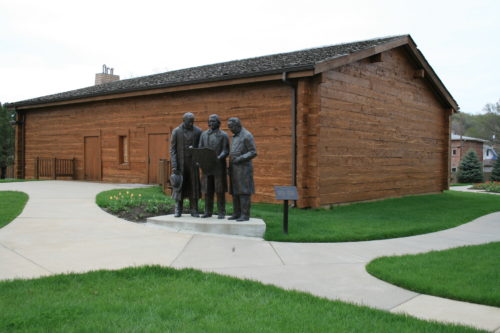
The Kanesville Tabernacle in Council Bluffs. Photo by Carson Ode
By Carson Ode
During the Second Great Awakening where the center of revivalism was in western New York, Joseph Smith, Jr. was searching for the right denomination to join. After praying over it, he said he received a vision in the spring of 1820, where he was advised by God, the Father, to join none of the existing churches because they were wrong. Additional angelic visitations followed culminating in God using him to re-establish the true Christian Church. The Book of Mormon, translated from writing on gold plates, would provide the means of establishing correct doctrine for the restored church. “By the gift and power of God,” Smith completed the translation and the plates were returned to the angel.
The Old and New Testaments of the Christian Bible are the primary sources for the Mormon faith. The Book of Mormon supplements these readings. Among the additions according to the Book of Mormon are the teachings that Nephites (descendants of Nephi, the fourth son the prophet, Lehi) sailed to the Americas at God’s urging. The year was c. 589 B.C. They had a belief in Christ hundreds of years before his birth.
The Mormon twists in the Christian faith caused problems in the eyes of other Christian denominations who thought the Mormons really weren’t Christians even though the Holy Bible was their guide. Smith and his followers left western New York where hellfire-and-damnation preaching was prevalent. They moved to Ohio where they found further resistance. Then it was on to several locations in Missouri where violence erupted. The governor of Missouri issued an “extermination order” forcing them out of the state. They fled to Illinois where they bought the small village of Commerce and named it Nauvoo.
Life became more settled for the Church of Jesus Christ of Latter-Day Saints (Mormons). The city of Nauvoo grew to about 12,000 residents (larger than Chicago). Work was begun on a temple. If Smith had not started getting visions of angels commanding him to break the law and take multiple wives, the voices of the Mormon Tabernacle Choir might be rolling across the Mississippi Valley today. (In an 1890 manifesto, church president Wilford Woodruff announced the end of plural marriages.)
Smith was killed in 1844 and mob violence increased during the summer of 1845. Brigham Young was chosen as the church’s leader. He encouraged the completion of the temple as the Latter Day Saints prepared to abandon Nauvoo. The temple was later heavily damaged by fire and a tornado finished it off. The temple you see today, as you look across the Mississippi River, was rebuilt to preserve Mormon history.
Finding a new destination to settle fell on Young. After the persecutions they had endured, he determined they should choose a location in the far West that no one else wanted. After studying information and consulting with mountain men and trappers, he chose the Great Salt Lake valley and basin in Utah.
In February of 1846, the Mormons began driving their wagons across the frozen Mississippi River and setting up camp on the banks of Sugar Creek (near Montrose) on the Iowa side. They left their warm homes on the other side of the river to huddle around campfires in sub-zero weather. Work was welcome to keep warm.
Young organized the people in units of 100 wagons, companies of 50 and sub-companies of 10, each with a captain. An advanced company of 100 men was sent ahead to scout the territory, build bridges, collect firewood and locate campsites.
TO READ THE ENTIRE STORY AND OTHER FASCINATING STORIES ABOUT IOWA HISTORY, subscribe to Iowa History Journal. You can also purchase back issues at the store.
